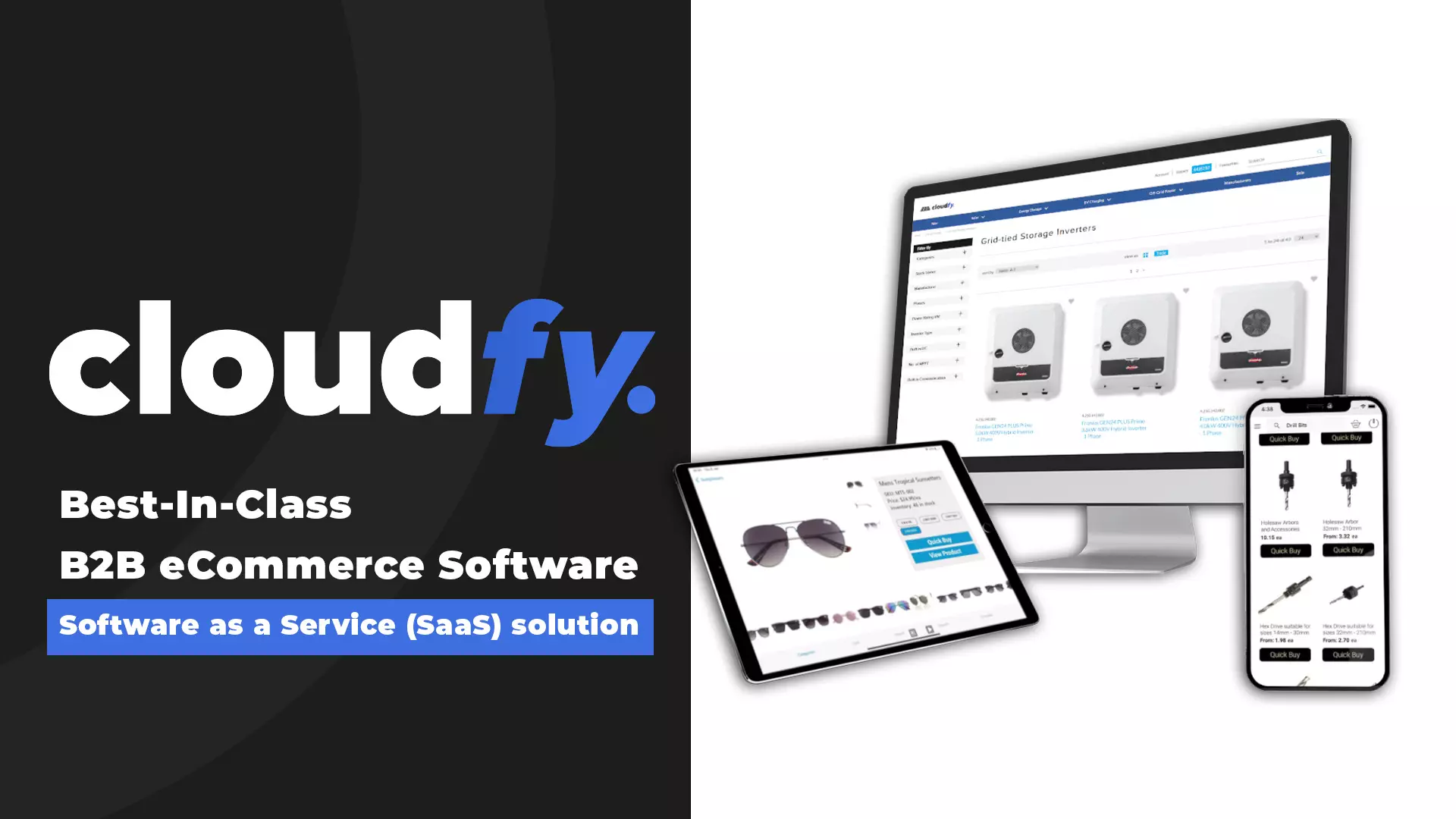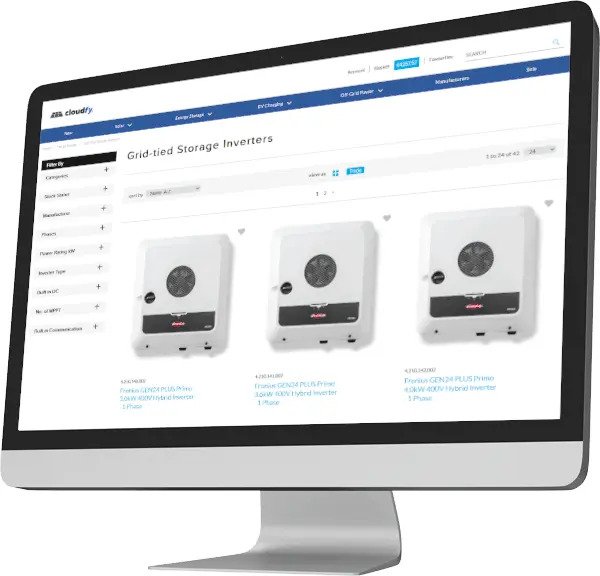Simplify, Save, and Scale with Cloudfy: B2B SaaS Ecommerce Made Easy
Struggling to keep pace in the digital B2B world? Cloudfy is your launchpad! This comprehensive B2B ecommerce platform boasts an extensive feature set, lightning-fast launch times, and surprisingly affordable prices. Customize your online store to perfectly match your specific needs and watch your business multiply with every click. Simplify operations, boost performance, and stay ahead of the curve with Cloudfy’s suite of powerful tools. Don’t wait, fuel your B2B growth with Cloudfy today!

Powerful search functionality
Meeting the challenges of complex B2B online sales. As your business grows, Cloudfy scales to meet your needs. Your trade customers can place their orders easily around the clock from anywhere in the world.
Cloudfy’s powerful B2B ecommerce features are purpose designed to meet the needs manufacturers, distributors and wholesalers. For almost a decade the team at Cloudfy has refined this powerful SaaS platform to meet your B2B ecommerce needs. You don’t need to look for third-party solutions to meet your unique requirements. Cloudfy is your one-stop-shop for online B2B sales.
Cloudfy comes complete with:
- a customer ordering app for anywhere, anytime purchasing
- a field sales representative app for customer support on the go
- pre-built enterprise (ERP) system integrations
- extensions for your favorite third-party solutions
- connectors for seamless integration with global B2B marketplaces and retail partners.
The Cloudfy team provides custom development, site set up, servers, security measures, and regular updates in the cloud. Because it’s a SaaS solution you can grow your business with the latest B2B ecommerce features and functions for a simple monthly subscription. There aren’t any hidden fees.

Find out more about Cloudfy’s purpose designed B2B ecommerce SaaS platform.
Cloudfy is your complete B2B ecommerce solution
| Key Features | Integrations | Extensions |
|---|---|---|
| Customer online self service | Enterprise resource planning (ERP) systems | Analytics |
| Business process automation | Product information management (PIM) | E-procurement |
| Powerful Page Builder | Warehouse management (WMS) | Marketing |
| Easy admin dashboard | Inventory management (IMS) | Payment gateways |
| Inventory visibility | Customer relationship management (CRM) | Shipping |
| Simple reordering | PunchOut | Tax and compliance |
| Digital marketing | Application programming interface (API) | Logistics |
PREMIER ORDERING PORTAL FOR TRADE -ONLY SALES
A purpose designed B2B ecommerce SaaS platform
Continuously meet and exceed your customers’ expectations for frictionless purchasing and scale easily as your business grows. Cloudfy provides all the advanced online ordering features you need, specially designed for complex B2B sales. Hosted securely in the cloud, you don’t need to invest in on-site IT equipment and expertise. You receive regular updates, so you’ll always current and competitive.
Outstanding B2B sales tools straight out of the box
Deliver outstanding B2B ecommerce performance without expensive customizations using Cloudfy’s pre-built B2B sales tools, integrations and extensions . You can have a new SaaS site up and running in a matter of weeks rather than months or even years. If you have specific requirements, we’re happy to create a tailored solution for you.
Automate processes to save time and money
Simplify your customers’ purchasing journeys and save time and money with business process automation. Cloudfy comes with pre-built integrations for leading business systems like Microsoft Dynamics, SAP and Oracle. Connect with leading B2B marketplace and integrate with warehouse, product information and customer relationship management systems. Cloudfy’s powerful API makes bespoke integrations easy too.
Easy e-procurement
Become part of your customer’s procurement solution with Cloudfy’s extensions for electronic data interchange (EDI) and PunchOut. Easy repeat ordering tools include Excel uploads and email templates. You’ll simplify customer reordering and help increase your conversion rates.
Ordering apps included
We know B2B buyers often place their orders using smartphones and tablet devices while they’re out and about. That’s why Cloudfy includes a customer ordering app and field sales representative app to use straight out of the box. Your customers can reorder their favorite products at any time and from anywhere.
International sales online
If your plans include international sales, you’ll want to meet your overseas clients’ procurement needs. Cloudfy’s multi-language and multi-currency functionality is available straight out of the box. Your international customers can pay using their preferred currency and browse your catalog online in their local language. There’s no need to build separate sites to meet your customers’ needs.

Your purpose designed B2B SaaS ordering platform
Your Cloudfy SaaS ecommerce site is more than just a wholesale ordering platform for your B2B clients. It’s designed to act as a central purchasing hub for your customers. They can access your product catalog, process their purchase orders, submit quote requests, and manage their invoices. It’s an easy to use online self-service portal for all their day to day purchasing needs.
With pre-built business system integration customers can view your products, inventory counts, pricing and their order histories in real time. When they place their orders the information transfers immediately to your back-office systems for processing and fulfillment.
A future-proofed B2B ecommerce SaaS solution
A SaaS B2B platform is a completely scalable solution that can grow with your business. Cutting-edge B2B features will deliver outstanding customer experiences and drive your digital strategy. You’ll also benefit from the most recent advances from the ever-evolving world of ecommerce with regular upgrades in the cloud.


Adaptable B2B ecommerce in the cloud
Your customers’ needs change quickly and their expectations increase all the time. To maintain your position as their strategic purchasing partner your B2B ecommerce system must expand, adapt, and grow. You can rely on Cloudfy’s continuing development to keep pace, without affecting your business operations.
Complete customer experiences
Modern B2B buyers have high expectations, based on their personal online shopping experiences. They want easy B2B purchasing processes, personalized service, fast fulfillment, simple repeat purchases, and around-the-clock online self-service. You can rely on Cloudfy to help you meet and exceed their expectations.


Keep sensitive data secure
Your customers want to know you will keep their sensitive information safe. Cloudfy takes security and privacy very seriously, so you can meet their needs with confidence. Your site will meet Payment Card Industry data security requirements along with international data protection regulations and quality standards. You’re protected against unauthorized access and criminal attacks by encryption, firewalls, and access controls.
And there's more…
- Personalized customer experiences
- Configure price quote (CPQ) tools
- Easy repeat ordering
- Quote processes
- PunchOut ordering
- Multi warehousing
- Multi-lingual & multi-currency tools.


Out-of-the-box Features for Manufacturers & Distributors
NOBODY OFFERS MORE B2B FUNCTIONALITY THAN CLOUDFY
MORE TOOLS FOR THE TRADE
FEATURED CASE STUDY
Macfarlane Group Plc is the largest supplier of protective packaging in the UK and Ireland. It serves over 20,000 businesses nationwide, focusing on reduced packaging costs and custom designed solutions. Each of the regional distribution centers has dedicated customer service, procurement, logistics and sales teams to meet customer needs. Each warehouse is stocked with the widest range of packaging products ready for despatch. The company chose Cloudfy as an experienced ecommerce partner to launch their new fully integrated B2B online platform. Read More
FEATURED CASE STUDY
Delice de France supplies fine frozen bakery goods, chilled items, beverages and ice cream to food services and retail partners. They receive hundreds of time critical B2B orders every day, mainly from hotels and cafés across the UK and beyond. The company creates new products regularly based on invaluable market insights and customer preferences. They were looking for a business partner to support their B2B ecommerce replatforming plans. Delice de France chose Cloudfy to deliver a modern scalable solution. The new site includes a bespoke online product comparison tool which provides valuable information about their customers’ purchasing choices. Read More
FEATURED CASE STUDY
Hexis manufactures and distributes self-adhesive vinyl signs, wrap-around films, and UV protective films for vehicles of all sizes. Their customers include auto body shops throughout the United States and Europe. The company needed to replace in-store ordering with a B2B ecommerce solution for manufacturers. ERP integration streamlines their processes and encourages online self-service. Cloudfy’s built-in content management makes it easy to post blogs and provide updated information. Read More
Frequently asked questions
Cloudfy’s ecommerce experts recognized the fast-moving B2B environment needed an ‘ever green’ solution to meet changing buyer expectations. Businesses don’t want to build custom B2B ecommerce sites. Most importantly, they wanted to stay ahead of the crowd with the latest functionality.
Yes. Cloudfy is recognized as a leading ecommerce platform for complex B2B sales. It delivers all the scalable B2B ecommerce features you need in the cloud, so it’s always flexible, scalable and up to date.
Your cloud-based B2B ecommerce site isn’t in a single place on a single server. That’s why you can rely on the highest levels of availability and scalability. You don’t have to invest in costly IT infrastructure; hosting, maintenance and support are all provided for you. As your business grows, your solution grows with you so it’s a future-proofed and cost-effective way to deliver leading-edge ecommerce.
You can change content, prices, customer information and manage your site every day with Cloudfy’s easy-to-use dashboard. It’s straightforward to change your site’s content or structure. You can choose the best colors, fonts, logos, banners and content to suit your brand and business needs. You receive our support to optimize your site for outstanding ecommerce performance and security. With regular updates and upgrades in the cloud you always have the latest features and protection. If you have any questions the Cloudfy team is on hand to help.
Around the clock monitoring and support mean we’re likely to discover and solve many problems before you even notice them. Thanks to Cloudfy’s unique platform and technology we can quickly resolve any issues in line with your agreed service levels.
Answers to more frequently asked questions about Cloudfy…
Accelerate business growth online with Cloudfy’s purpose designed B2B ecommerce features.























